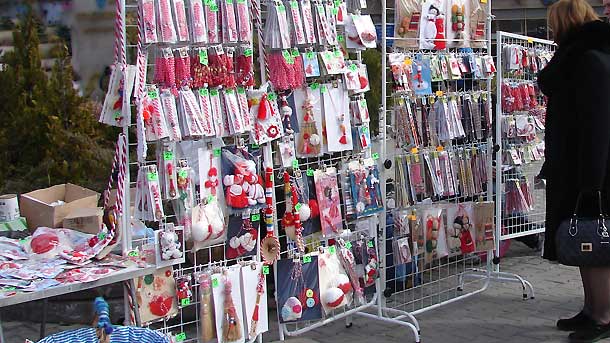On 1 March the whole of Bulgaria shines in white and red. Everyone goes out adorned with tassels made of white and red threads. The sun is stronger, the day grows longer and people tend to smile more often. The winter retreats as the spring is gets in bringing hopes for health, luck and prosperity. And this has been going on for 1300 years! March 1, or Granny Martha, is celebrated in Bulgaria only. On this day even Google is dressed up in white and red, to honor the unique tradition of Bulgarians!
Way back Granny Martha lived away, in the mountain
She saw and heard everything that was happening in the world. When Granny Martha (her name derives from the month of March) smiled, the sun shone in gold, birds twittered merrily and the grass assumed a new lush greenness. However, whenever Granny Martha was angered, dark clouds fell above the mountain, winds and blizzards whipped the woods, cold froze the earth and birds went silent. So, since olden times, Bulgarians have made twisted white and red threads that children and young girls should wear; tied them to sheep, cows and orchard trees to appease Granny Martha. Red threads were tied in front of every house. In this way protection against evil people and disease would be provided. When Granny Martha saw the decoration she smiled and the sun went up, brilliant. Therefore, replicating the tradition, every year on 1 March we give each other martenitsa tassels, lovely amulets in red and white named after the month of March.
Why red and white
The colors of the martenitsa carry the symbolism and magic of ancient times. The red thread is about strength, blood, sun and warmth. In fact, red is a dominant color in traditional Bulgarians costumes and embroideries. The white thread in turn, stands for good and light. Tradition prescribes to remove the martenitsa once we sight the first stork for the year and to place the tassels under a large stone. Nine days later we check what kind of bugs have gathered under the stone. The more they are, the greater the fertility during the new farming season. In other versions of the same tradition, the martenitsa should be thrown in the river so that everything goes smooth in our lives. There is still another ritual. A day is selected in the bracket from March 1 to 22. Depending on what the weather is on this day, we judge about our luck during the year. If it is sunny and warm, then luck will be on our side; if it is cold and dark, prepare to see a shortage of good luck. Well, this is how it was, way back.
 Bulgaria: a huge martenitsa
Bulgaria: a huge martenitsa
Today, the red and white martenitsa is a token of love, health and longevity. The white comes across with a message about the purity of relations between people, while red denotes the warmth of friendship. For this reason, many Bulgarians make martenitsas investing a lot of emotions addressed to their recipients. On 1 March everybody wears the precious adornment. Though the traditional amulet is made of wool, both the material and designs have changed over time to include other colorful threads, beads, wooden pellets, plastic images of cartoon heroes for kids etc. In the recent years bracelet martenitsas have become increasingly popular. On 1 March the greatest fans of the tradition dress all in red and white. Martenitsas are tied to cars, pets, decorate cafes and stores, windows and yards. If we fail to sight a stork until 25 March, then the martenitsa is tied to a fruit tree. In this way, Bulgaria turns into a huge martenitsa during March.
Legends 1300 years of age
The legends about the origin of the Bulgarian martenitsa are a few, all related to the Proto-Bulgarians and the founder of the Bulgarian state in the Balkans, Khan Asparuh. One of them takes us 1300 years back. Asparuh headed west to look for a new land for Bulgarians after the Huns defeated his motherland and took away his sister Houba. He arrived in the present-day Bulgarian lands and sent a message to his sister on the wings of a falcon. Asparuh wrote to her that he had found a paradise to the south of the Danube and would settle there. Houba ran away and tied a white silk thread to the falcon to herald her return. The falcon took her to the new land but an enemy’s arrow pierced the bird and the thread turned red. After the good news about the survival of his sister, Asparuh tore bits from the thread and tied them to soldiers’ hands. Then he issued an order for the two colors to never be separated thus safeguarding the unity of Bulgaria. It was March 1, 681, the then-New Year. The silk thread was named martenitsa, after the name of March. Since then, the red-and-white thread connects Bulgarians across the globe, being a memento from the motherland of our first khan.
English version: Daniela Konstantinova
Madlen Bozhilova Amin is the winner of the 2021 UNESCO's Living Human Treasure prize for a project related to the making of the old-time folk costume from the region of Kyustendil called "saya" . Some time ago, the Bulgarian woman returned from abroad to..
For the 8th time, Kardzhali is hosting the Folklore Festival of amateur folk dance clubs "Perpera". The forum will gather today on the stage of the theater in Kardzhali more than 420 amateur dancers from all over the country. They will perform..
Bulgarian national folk costumes from the Rhodope region inspired young European designers, finalists in the Open Space Foundation's Echo Academies project , BTA reported, citing Alma Communication. In the recently concluded first stage of the..
Eight days before Easter, we celebrate Lazarus Saturday (St. Lazarus Day). It is the first of the three major Christian feasts associated with the miracle..

+359 2 9336 661
